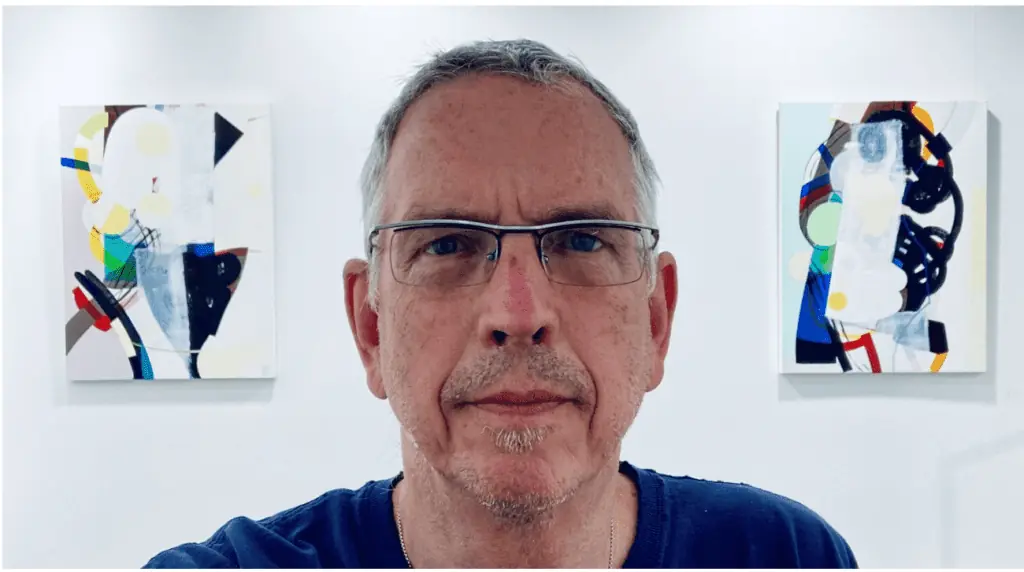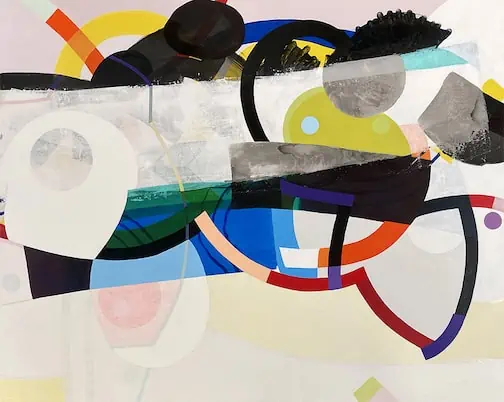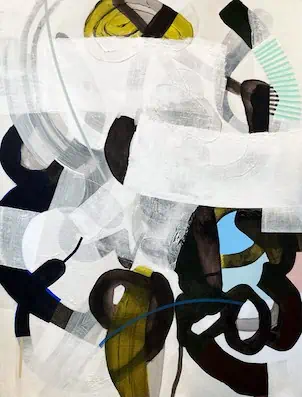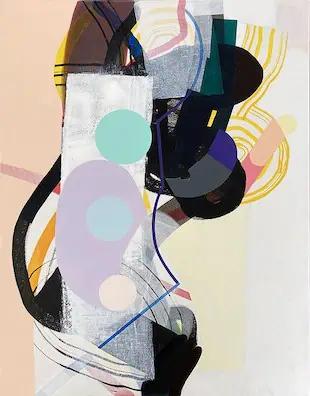
At what age did you first suspect that you were an artist?
I was always creative, and liked to draw. I had strong eye-hand coordination and could look at something and get a fairly good representation. But my artistry became more solidified in high school art classes. I had a great art teacher, Carl Weiss, at Glasgow High School in Glasgow, Kentucky where I grew up. He always encouraged me, and he really got me to think. He told me, “You should be an artist.” I’d never had an art teacher tell me that.
Did you study art in college?
I couldn’t really think of anything else I wanted to do [besides art] to be honest with you, so I ended up going to Murray State University in Western Kentucky where I got my BFA. Following that, I got an apprenticeship with a painter named Gregory Gillespie who lived in East Hampton, Massachusetts at first, and then built a wonderful studio in Belchertown. I studied with him for a couple of years, and then took a little time off and ended up going to University of Massachusetts, Amherst, where I got my MFA in painting.

What attracted you to abstract painting?
Oh, that really came later. After I got out of university, I was always doing representational or symbolic art. I got into metaphysical ideas where everything had symbolic meaning. I started to ask myself questions like, what is it that lies underneath? What’s the energy? So I started to think about things a little bit differently, and as I did, my paintings started to shift in their orientation. Then, systematically, by asking questions I went deeper into abstraction.
In 1990 during a critique with the Philadelphia artist and teacher Moe Brooker he challenged me to work with a new medium, I thought dried fish. So, I started to work with fish. I would go to the Asian food store, and buy dried fish in a bag, and then I would embed these fish onto a board or canvas with modeling paste and build the composition. Well, this really helped me switch from representational to abstraction, and made me think differently. It opened up a new channel to seeing things differently.
Describe your work process.
I work a lot. I don’t need to have an upcoming show to create. I think visually—that’s how I process information and the energy that comes from it. I always start a group of paintings or a body of work by gathering information or data, if you will. That can come from making drawings or taking photos on my phone. When I work with digital video, another medium I use, I’ll gather a lot of images then go back and start to edit.
How long have you been teaching?
I started teaching in grad school. I learned that I could get a teaching assistantship and get paid to go to school. I took advantage of that. I’ve been at it for about forty years. I’ve taught at The Art League for about five years starting as a substitute for Deanna Schwartzberg’s Abstract class.
You teach three courses at The Art League: Color Theory, Abstract Principles, and Abstract Painting. What can students expect to learn in each?
Color Theory is about how we look at color—qualities like light and dark contrast; temperature; saturation; how to mix color; which colors work well with each other and which don’t. The projects in this class are designed to broaden students’ vocabulary about color. It is important to isolate color from content to get a more objective and subjective understanding. From there the students can incorporate their understanding into their work.
Abstract Principles is a foundational course that I have taught for over 30 years. In it I instruct students on how to single out different visual aspects like line, mark making, plane, form, balance, positive and negative space, and kinetics so that they look at things in a very direct way rather than drawing the way that they normally do. It teaches them how to see things individually so when they create they have a better command, more choices, based on a deeper understanding.
Abstract Painting is just a big free for all. you know. I’m not the kind of teacher that goes, “Okay, I’m going to show you this and that, and you’re going to do these paintings.” People come in and they’ll have ideas, or even if they don’t I’ll talk and make suggestions and let them start to formulate ideas. Everyone is doing their own thing, finding their own way. I am there assisting and helping them if they get stuck or have questions. It’s important that they know who they are as an artist and work from that place. There’s a great camaraderie that happens in the classroom. It’s a diversely fun environment.
Who are your classes for, beginner or experienced artists?
All levels are welcome, I find sometimes that it is the students who have less training that make the best work. Then it is my job to help them understand and develop or just keep going. I enjoy working with experienced artists very much, we challenge each other, make each other think. It’s all about development from where you are.
Does teaching affect your understanding of painting?
I think the question really is, does my painting affect my teaching? Because, no matter what I’m teaching, I use the same basics. I’m not one for tricks or gimmicks, or anything like that. I always have to look at my own work, and it’s no different from looking at works by my students. It all comes down to design structure, color structure, and light and dark structure. Those three variables are always present. In teaching as a working artist I’m reminded to practice what I preach. So it does come back to me and keeps me focused on different ways to look at my work. Teaching keeps me fresh.
Do you make art— sketch, paint, or create something—every day?
My grandmother was an artist and she used to tell me it is important to go to the studio everyday. I do that. My main days for work, where I spend hours, I am able to accomplish more. But sometimes it is 30 minutes or an hour that lets me shift something that was ready to be changed.

What are you currently working on?
About twenty-five paintings, all different sizes. My approach is to take risks, I believe that as an artist it’s the way we grow. I have a strong sense of color so in this body of work I am limiting my use of color to a supportive role, taking a back seat to white and black by emphasizing the use of powdered pigment and medium to create broad strokes of white across the surface. I am interested this time in the interactions of the world; the natural, the societal, the personal, and the internal world we all live in.
What was the pandemic period of shutdown like for you creatively?
It was a double-edged sword. On one hand it was really good for me because it took away all of my time wasting habits and I just got to focus on the work. I was very prolific and still am. And at the same time I had personal difficulties, tragedies in our family that happened, so I was hit with that.
I had a show at the Fred Schneider Gallery titled Flattening Time where I was asking a question, what is consciousness? It had been planned and I was working on it before Covid, but when it came time to show the work, not many came out.
I lost teaching jobs [due to the shutdown], so that was very tough. But I also learned how to teach online, and that came in handy for the long distance students, recently I had a young woman from Nairobi, Kenya—eight hours ahead—in one of my classes. The whole period has just been extraordinary.
Who are some of your favorite artists?
Brian Eno, musician; Ethelbert Miller, poet; Ashraf Fouad, composer; Carol Bean, poet; J. P. Joffrey, musician; Ian Khan, singer; Nikola Paskalov, musician, the Coen Brothers—Joel and Ethan—filmmakers; dancers Pina Bausch and Lucy Bowen McCauley; musicians Alva Noto and Ryuichi Sakamoto…The list goes on! I’m affected or influenced by these guys. And good food. (laughs)

Is there a particular artist whose process has influenced you?
The one who really influenced me in terms of process Gregory Gillespie who I apprenticed with. I got to know him because of a project that I was doing at Murray State University. I took some small paintings I had done for my senior show to his studio for him to see. He asked if he could work on one. I said yes, and he took out a razor blade and started to scrape the painting down.
When I tell that story, many people are mortified that he took my finished work and started to scrape it down. But it didn’t bother me at all because this is how he treated his own work, and by doing that he showed me, in a very direct way, how to take my work to a new level. By destroying it he opened the door for something new. Even though my work is completely different now that whole process has stayed with me.
Is there something that you have yet to achieve, or something that you’re working towards?
I’m always working towards something. I would like to have my work exhibited more broadly and placed in collecting institutions and museum shows. That’s what I am focusing on.
What’s next for you?
I am currently finishing the work in the studio and will have it photographed. After that I am ready to find new places to share the work. I will be ready.
What do you wish was different about art and its place in society?
I think that the arts need to be taken seriously in school curriculums. The curriculum is set up to minimize the core essence of being creative by considering it as an elective. I think that if that was resolved we wouldn’t even be having to ask that question, it would just naturally unfold and hold a meaningful place in people’s lives. We see it’s importance in other cultures much older than ours and how they embrace the arts. If we can create that kind of atmosphere our society would be in a better place.
Sign up for our weekly blog newsletter, subscribe to our RSS feed, or like us on Facebook for the latest Art League news. Visit our homepage for more information about our classes, exhibits, and events in Old Town Alexandria, Virginia.
You can support The Art League every time you shop through AmazonSmile!
Simply set The Art League as your chosen charity, and every time you shop at smile.amazon.com, a portion of your purchase will be donated to support our mission to share the experience of visual arts with the community.